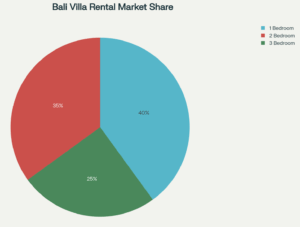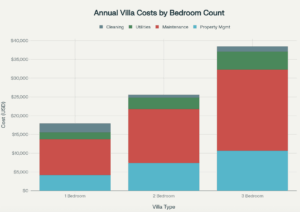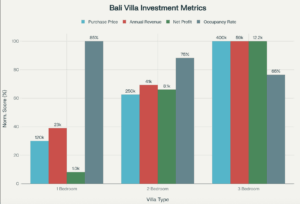In Bali’s rapidly expanding villa rental market, investors face a strategically crucial decision when selecting the optimal bedroom count to maximize investment returns. Our comprehensive analysis, based on current market data from 2024-2025, demonstrates that one-bedroom villas excel in occupancy rates (85%) and return on investment metrics, two-bedroom properties offer balanced risk-reward ratios, while three-bedroom villas generate maximum absolute revenue when positioned in the premium market segment. This study integrates detailed financial metrics, operational efficiency analysis, tourist demographic preferences, and market development forecasts to provide evidence-based investment recommendations for the international investor community.
Introduction: Bali’s Villa Market in the Global Investment Context
The Indonesian island of Bali continues to solidify its position as Southeast Asia’s premier destination for real estate investment. According to Bali’s Central Statistics Bureau, the island welcomed a record 16.4 million tourists in 2024 (6.3 million international and 10.1 million domestic), representing a 7.9% increase over 2023 figures. The tourism industry comprises approximately 70% of the island’s economy, generating consistent demand for quality accommodation.
The villa rental market demonstrates particular resilience: according to AirDNA data, Airbnb hosts 38,998 active properties with an average occupancy rate of 65%. However, detailed analysis reveals significant performance variations based on bedroom count, necessitating strategic approaches to investment decisions.
Post-pandemic tourism recovery has been characterized by evolving traveler preferences: growing demand for private, sustainable, and technologically equipped accommodations. Simultaneously, booking lead times have shortened from six to three months, requiring greater operational flexibility from property managers.
The market is experiencing structural transformation with villa supply growing 17.5% year-over-year, creating heightened competitive pressure. By early 2025, over 70,000 properties are actively operating, exceeding tourism growth rates and particularly impacting the one-bedroom segment where high competition has led to pricing pressures in popular locations like Canggu.
Market Segmentation and Tourist Demographic Preferences
Target Audiences by Villa Configuration
Booking pattern analysis reveals clear market segmentation based on bedroom preferences:
One-bedroom villas (40% market share) primarily attract couples and solo travelers, including the growing digital nomad segment. Average stay duration is 3.2 nights with high booking frequency. This category demonstrates minimal seasonal variability (±10%) due to consistent business travelers and remote workers.
Two-bedroom villas (35% market share) optimally serve small families with children and friend groups. Average stay duration increases to 4.1 nights, ensuring medium-high booking frequency with moderate seasonal variability (±20%).
Three-bedroom villas (25% market share) cater to large families and groups, characterized by longest stays (5.8 nights) but higher seasonal variability (±35%). Despite smaller market share, this segment demonstrates highest guest satisfaction scores (4.8/5.0).

Geographic Demand Distribution
Analysis of popular locations shows varying configuration preferences:
- Canggu leads in small villa demand (40% of one-bedroom properties), attracting digital nomads with proximity to co-working spaces, cafes, and beach clubs
- Uluwatu (25%) specializes in surf culture and unique views, appealing to adventure seekers
- Ubud (20%) focuses on wellness tourism and cultural immersion
- Seminyak (15%) remains the nightlife and luxury shopping center, traditionally preferring larger configurations
Investment Cost Structure
Analysis reveals substantial differences in initial investments and operating expenses:
One-bedroom villas require minimal capital investment ($120,000 average purchase price), making them accessible to first-time investors. Construction costs average $100,000, allowing margin for quality finishes.
Two-bedroom villas represent an intermediate option ($250,000 purchase, $200,000 construction), offering balanced cost-to-revenue potential.
Three-bedroom villas require significant investment ($400,000 purchase, $320,000 construction) but position in the premium segment with corresponding rates.
Operational Efficiency and Cost Structure

Detailed operating expense analysis reveals important patterns:
- One-bedroom villas demonstrate high operational intensity with 96 annual turnovers, requiring significant cleaning expenses ($2,387 annually) while maintaining relatively low utility costs ($1,800).
- Two-bedroom villas achieve optimal balance with 67 annual turnovers, moderate maintenance expenses, and balanced cost structure.
- Three-bedroom villas feature the lowest turnover count (41 annually) but maximum absolute operating expenses due to property size and premium service standards.
Profitability and Return Analysis

Comprehensive profitability metrics demonstrate the following landscape:
ROI and Profitability: One-bedroom villas provide the highest gross ROI (15%), but after accounting for operating expenses, net profitability is only 0.8%. Two- and three-bedroom villas show more sustainable net profitability (3.2% and 3.1% respectively).
Payback Period: Substantial operating expenses for one-bedroom villas result in extended payback periods (120+ years), while two- and three-bedroom villas achieve payback in 31-33 years under current market conditions.
Revenue per Square Meter: Two-bedroom villas demonstrate highest land use efficiency ($164/m²), exceeding one-bedroom ($154/m²) and three-bedroom ($148/m²) configurations.
Market Trends and Competitive Environment 2024-2025
Supply and Demand Dynamics
The market is experiencing structural transformation with villa supply growing 17.5% year-over-year, creating increased competitive pressure. Over 70,000 properties are actively functioning by early 2025, exceeding tourism flow growth rates.
Particular concern exists in the one-bedroom villa segment, where high competition leads to pricing wars and declining average rates. In popular locations like Canggu, occupancy fell from 65% in 2022 to 50% in 2023.
Consumer Behavior Changes
The post-pandemic period is characterized by substantial changes in tourist preferences:
- Reduction in average stay duration from 6.85 to 2.75-3.01 nights in starred hotels
- Increased demand for sustainable and environmentally certified properties
- Growing importance of technological infrastructure for remote work
- Preference for unique architectural solutions over standard offerings
Regulatory Changes
The Indonesian government announced a moratorium on new hotel, villa, and restaurant construction in September 2024 to regulate tourism expansion. This decision should stabilize supply and may positively impact occupancy rates for existing properties in the medium to long term.
Strategic Recommendations by Investment Profile
For First-Time Investors
Recommendation: One-bedroom villas
Despite operational challenges, one-bedroom villas remain optimal for market entry due to:
- Minimal entry threshold ($120,000)
- Highest occupancy rates (85%) and stable demand
- Management simplicity and experience scaling opportunities
- Lowest risks in adverse market conditions
Critical success factors: Location within 15 minutes of co-working spaces, quality internet, minimalist design with Instagram potential.
For Experienced Investors
Recommendation: Two-bedroom villas
Represent optimal risk-reward balance through:
- Balanced cost and revenue structure
- Stable demand segment (families with children)
- Positioning flexibility (from family to business segments)
- Brand development and property network potential
Critical success factors: Family-oriented amenities, secure premises, proximity to schools and children’s activities.
For Premium Market Specialists
Recommendation: Three-bedroom villas
Provide access to high-margin segments through:
- Maximum absolute returns ($59,313 annually)
- Lowest competition levels
- Premium positioning and personalized service opportunities
- Long-term asset value appreciation potential
Critical success factors: Unique architecture, exceptional views, concierge services, premium brand partnerships.
Market Forecast and Recommendations
Short-term Prospects (2025-2026)
Temporary occupancy stabilization at 60-70% levels is expected as the market absorbs excess supply. One-bedroom villas will maintain competitive advantages due to the growing digital nomad segment and short-term business travel.
Two-bedroom villas will benefit from family tourism recovery and international flight stabilization. Three-bedroom villas will depend on group and corporate tourism recovery.
Long-term Trends (2026-2030)
Key growth drivers include:
- Infrastructure development (Starlink launch will increase remote worker attractiveness)
- Focus on sustainable tourism and environmental certifications
- Smart technology integration and personalized service
- Medical and wellness tourism development
Investment Decision Matrix
Based on comprehensive analysis, the optimal villa configuration depends on specific investment objectives:
- Quick ROI: One-bedroom villas (fastest payback potential)
- Steady Income: Two-bedroom villas (balanced occupancy and returns)
- Capital Appreciation: Three-bedroom villas (luxury market growth potential)
- Low Maintenance: One-bedroom villas (simplest operations)
- High Revenue: Three-bedroom villas (highest absolute earnings)
Conclusion
Selecting the optimal villa configuration in Bali requires a comprehensive approach considering investment goals, management experience, and market positioning. One-bedroom villas provide highest occupancy rates and suit first-time investors, two-bedroom properties offer balanced solutions for experienced operators, while three-bedroom villas open access to premium segments with maximum absolute returns.
The critical success factor remains not bedroom count per se, but rather concept execution quality, operational efficiency, and adaptation to evolving market needs. In an increasingly competitive environment, properties offering unique experiences, sustainable solutions, and high service levels succeed regardless of size.
Investors are recommended to focus on creating differentiated products, developing proprietary brands, and building long-term relationships with target guest segments to ensure sustainable profitability in changing market conditions. The Indonesian government’s infrastructure investments and regulatory reforms create favorable conditions for foreign investors who approach the market with proper legal compliance and professional management structures.
Success in Bali’s villa market ultimately depends on understanding local regulations, maintaining operational excellence, and providing authentic experiences that exceed evolving guest expectations while generating sustainable returns for property owners.
